📝📓Life in Progress Notebook: Transforming Planning and Journaling into Growth-Driven Life-Logging
Workflows and SetupsIf you like my notebook system, please consider leaving a small tip as a gesture of support here. You can also show your support by commenting, emailing, sharing it.
We all live within the continuous flow of time, yet the meaning and purpose behind how we live differ and evolve day by day, moment by moment. We harbour aspirations to pursue, intentions to act upon, and reflections to learn from. Most of us strive to progress towards the life we envision, trying to bridge the gap between that ideal life and our current reality as much and as soon as possible. However, the gap between the life we desire and the one we live largely depends on the wisdom we gain from each moment.
If you don’t know who you are right now, you won’t know how you can improve. Likewise, if you don’t know where you want to go, you cannot determine the path you should take. Therefore, personal growth relies on gaining a deeper understanding of yourself, fostering a sense of purpose and direction in life, and building a foundation that aids in overcoming challenges and obstacles along the way.
“Life can only be understood backwards; but it must be lived forwards”
— Søren Kierkegaard
Although we cannot retrace our steps, we can leave breadcrumbs that mark how far we’ve progressed and in which direction.
In this context, this Life in Progress Notebook system, in a way, acts as a series of breadcrumbs marking your path, indicating your current position in your journey, and helping you decide your next step.
As you progress, moment by moment, aligned with your personal compass towards a self-chosen meaning of life, you live forwards while gradually gaining an understanding of your life in retrospect.
While My Life at a Glance Notebook: A Journal & Planner System for Seeing Life Clearly, allows you to see where you stand and the route you have taken at a glance, this Life in Progress notebook system will assist you in seeing the trajectory of your life from past to present, and how you can adjust your course when needed. This fosters a mindset of continuous self-discovery—understanding your intentions, actions, lessons, and values—cultivating a sense of fulfillment and purpose through living and reflecting.
Why Other Methods Didn't Work for Me as a Personal Growth Tool
The issues with typical planners
Physical planners are too rigid, focusing solely on intention setting, without considering broader areas of focus, so you cannot see a comprehensive view of your roles and responsibilities. They also don’t account for the ebbs and flows of life that affect your plans. Sure, we aim to live forward, but cannot precisely plan each next step. Beyond setting intentions and planning, you need to follow through and be capable of adjusting your course of action when necessary.
Moreover, there is no integrated reflection session connected to your intentions. Physical planners lack the space to track your progress simply and meaningfully, side by side with your reflections on that progress. This means they don’t help you honestly confront time constraints and your (unavoidable) shortcomings.
…Planning alone is not enough: accountability is the key to success…
The issues with daily journaling (prompts)
They usually focus on your day-to-day thoughts and feelings and tend to make you ruminate instead of progress. Due to the nature of a blank space, they lack materials for purposeful reflection. You don't have your breadcrumbs of how many steps you take and in which direction you have been walking on this path.
Instead, you just accumulate your answers day by day but without a clear, organized way to make it useful. You cannot clearly see the patterns of your life, and you can't reflect on it in a meaningful way. Think of it as filling out a survey form; those data only matter and are usable when you compile and organize them by questions, not by the filled form in each instance. It is, therefore, really important to have structured layouts that can help you see patterns within your answers and reflections.
…Accountability is not enough; reflection is the key to wisdom…
The issues with almost any other tools (especially digital tools)
They don't really have the space for you to reflect on each of your actions, so you don't know what the lessons or key takeaways are, what you can avoid, reconsider, pivot, or re-implement for later. They also only care about your actions, not your values. This fixation on achievements or the lack thereof often neglects your own character. You may start reflecting on each step you take but not whether it aligns with your moral compass or your personal virtues that make your life worth living. There would be, if there is any at all, only a vague area for you to write down something about your values, but without clear guidance and concrete evidence of how you practice those values.
…Reflection is not enough, your personal values is the compass towards a life worth living…
Life Navigation Framework: Sailing Your Life Journey
Envision yourself as the captain of a ship journeying through the vast, unpredictable sea of life. The catch is, you won't find out your final destination until you actually arrive there. So, how can you navigate your life under the circumstance where your destination is unknown? With the possibility of sailing in any direction, there's no right or wrong in how to live. How, then, can you chart your life course with this understanding?
The key lies in how you sail, not just where you end up.
Power Your Ship: Focus Forces (Energy & Effort)
First, your ship must be functional and ready to move. In life, this means having enough focused energy, your Focus Forces, to propel you forward. These represent the key areas where you invest your energy and effort, such as work, personal, wellness, and household roles and responsibilities. Like multiple engines working together, your Focus Forces keep your life's sail filled with power. It's vital to understand where and when to direct your energy for each Focus Forces to move forward with clear intention, and build up the momentum to move faster.
Align Your Inner Compass: Personal Core Values (Purpose & Meaning)
Next, you need direction. Since there is no fixed destination for everyone, you must choose your own path by actively aligning your Inner Compass—clarifying and living your core values and virtues. This compass doesn't give exact coordinates but points you toward your true north, helping you live with integrity and purpose. When life's storms push you off course, your Inner Compass helps you reorient and keep moving forward in your intended direction.
Take the Helm: Steering Wheel (Accountability & Control)
How do you ensure you stay on course? That's your Steering Wheel; the tool of control and accountability. By regularly steering your life’s path, you adjust your efforts and actions to stay aligned with your core values. The Steering Wheel empowers you to make course corrections and actively navigate your journey in harmony with your Focus Forces, and Inner Compass.
Drop Your Anchors: Life Dimensions (Balance & Stability)
When the seas get rough, you drop your Anchors—actively grounding yourself in your life's foundational dimensions. Anchors keep you steady, offering a chance to pause, reflect, and regain balance. These anchors help you resist being swept away by life's currents and maintain a strong foundation. (You can read more about this concept on My Life at a Glance Notebook)
Log Your Journey: Logbook (Lessons & Wisdom)
Finally, you need to actively decide where exactly you want to go next. So, how can you learn from your experiences and grow wiser along the way to understand and navigate your life? This is where your logbook becomes invaluable. Your Logbook is your continuous journal, recording daily reflections, insights, and lessons. Along the way, you mark Waypoint Logs—special milestones highlighting breakthroughs or courses adjustments. Together, they create a personal map of your journey, helping you make informed decisions as you sail onward.
This Life Navigation framework harmonizes life's complexities into an inspiring system.
- Grounding—Anchors (Balance & Stability): Provide stability, allowing you to pause or resist external forces, grounding you when needed.
- Direction—Inner Compass (Purpose & Meaning): Your inner guidance system, pointing you toward meaningful directions aligned with your values.
- Momentum—Focus Forces (Energy & Effort): The dynamic personal efforts and energies in your core life areas that give your power to move forward.
- Accountability—Steering Wheel (Accountability & Control): Your control mechanism that lets you actively steer and keep you on course toward your chosen direction.
- Reflection—Logbook (Lessons & Wisdom): Your detailed journal of ongoing experiences (Logbook) combined with highlighted milestones or insights (Waypoint Logs) to guide course corrections.
Your ship is your life; your Focus Forces propel you forward; your hands control the Steering Wheel to navigate your course; you align your Inner Compass to guide your direction; you drop your Anchors to maintain stability; and you log the journey in your Logbook, making it your trusted advisor for decision-making. Together, these elements empower you to intentionally sail through the vast ocean of life with meaning and purpose throughout your journey.
This Life in Progress notebook system, in conjunction with the "My Life at a Glance Notebooks Systems" (based on Anchors of Life), made up into this Life Navigation framework. This offers a comprehensive view of your life and how you can navigate it on your terms, empowering you to move forward with clarity, control, intentional effort, and ongoing learning towards growth and life progress.
Life in Progress: The Self-Growth With Purpose and Meaning
Life in Progress integrates the Life Navigation Framework into a simple yet practical system that helps you visualize your growth through timelines (progression over time) and milestones (progression through achievements). This lets you see your life’s trajectory clearly, like mapping your journey through time.
Growth is not just about moving forward, though. It also means taking steps back to reflect on each move. That’s why Life in Progress emphasizes capturing short personal reflections for every step, helping you understand where you are, what you’re doing, why, and how you’re advancing. This approach blends both qualitative insight and quantitative progress tracking, all within one notebook.
At its core, Life in Progress is about:
- Logging your actions on a timeline,
- Capturing observations and insights on each action,
- Incorporating them into deep reflections, and
- Listing key milestones to mark your growth.
Think of this notebook as purposeful life-logging, instead of journaling (which can be spontaneous) or planning (which only sets intentions). It combines intention, commitment, and reflection, helping you visualize progress and log the breadcrumbs of your journey towards your values and focus areas.
Life in Progress notebook is where you log your life, and where your life becomes a living record of your own wisdom, lessons, insights, and experiences.
However, since personal growth is, well, personal. How you define growth and progress can vary from person to person. Although I share methods for using these tools and systems for self-growth, you can decide which parts resonate with you and help you understand yourself and your unique path
To reflect this, the system is divided into the core system and the support system. The Core System (Life Navigation) provides a timeline-based perspective of your journey through monthly growth and quarterly reflection, while the Support System (Life in Focus) offers targeted tools for managing projects and commitments.
The Core System: Life Navigation
This core systems helps you understand how you live by logging the breadcrumbs of your experiences and insights at the moment, combining Monthly Growth and Quarterly Reflection.
Monthly Growth (daily logging):
- Monthly Dashboard:: Overview of your areas of focus, projects, and alignment with your personal compass.
- Monthly Intention (Focus Forces): Choose and schedule effort and energy priorities for the month; review weekly progress and how you can improve your next week’s plan.
- Monthly Character Log (Inner Compass): Track daily virtues and vices aligned with your core values.
- Monthly Accountability (Steering Wheel): Log daily activities, that drives progress toward milestones, along with your observations and insights.
Quarterly Reflection (post monthly logs):
- Quarterly Milestones: List weekly big wins from Focus Forces (work, personal, health, and household)
- Quarterly Focus: Reflect on outcomes and lessons learned in each focus area.
- Quarterly Integrity: Assess your practice of personal values.
- Quarterly Lessons: Highlight insights that significantly impacted your growth.
Now let's get into the the notebook layouts for Life in Progress.
Monthly Growth: Setting Intention and Course Correction
Monthly Growth is the heart of the Life in Progress system. This is where you gain a holistic monthly overview, set focused intentions for the month (Focus Forces), practice your core values (Inner Compass), and hold yourself accountable to follow through or adjust plans as needed (Steering Wheel). Each aspect is supported by its own layout: the Monthly Dashboard, Monthly Intention, Monthly Character Log, and Monthly Accountability. These hands-on tools ensure that each month you move closer to your meaningful destination.
The Monthly Dashboard:
The Monthly Dashboard provides a high-level overview of your commitments, progress on Focus Forces, and alignment with your Inner Compass. It also invites short reflections on your projects and values for the month. Monthly Dashboard serves as a monthly overview for how you fair you are in your commitment and on Focus Forces, and Inner Compass of that month, along with some short reflections on outcome-based, or value-based.
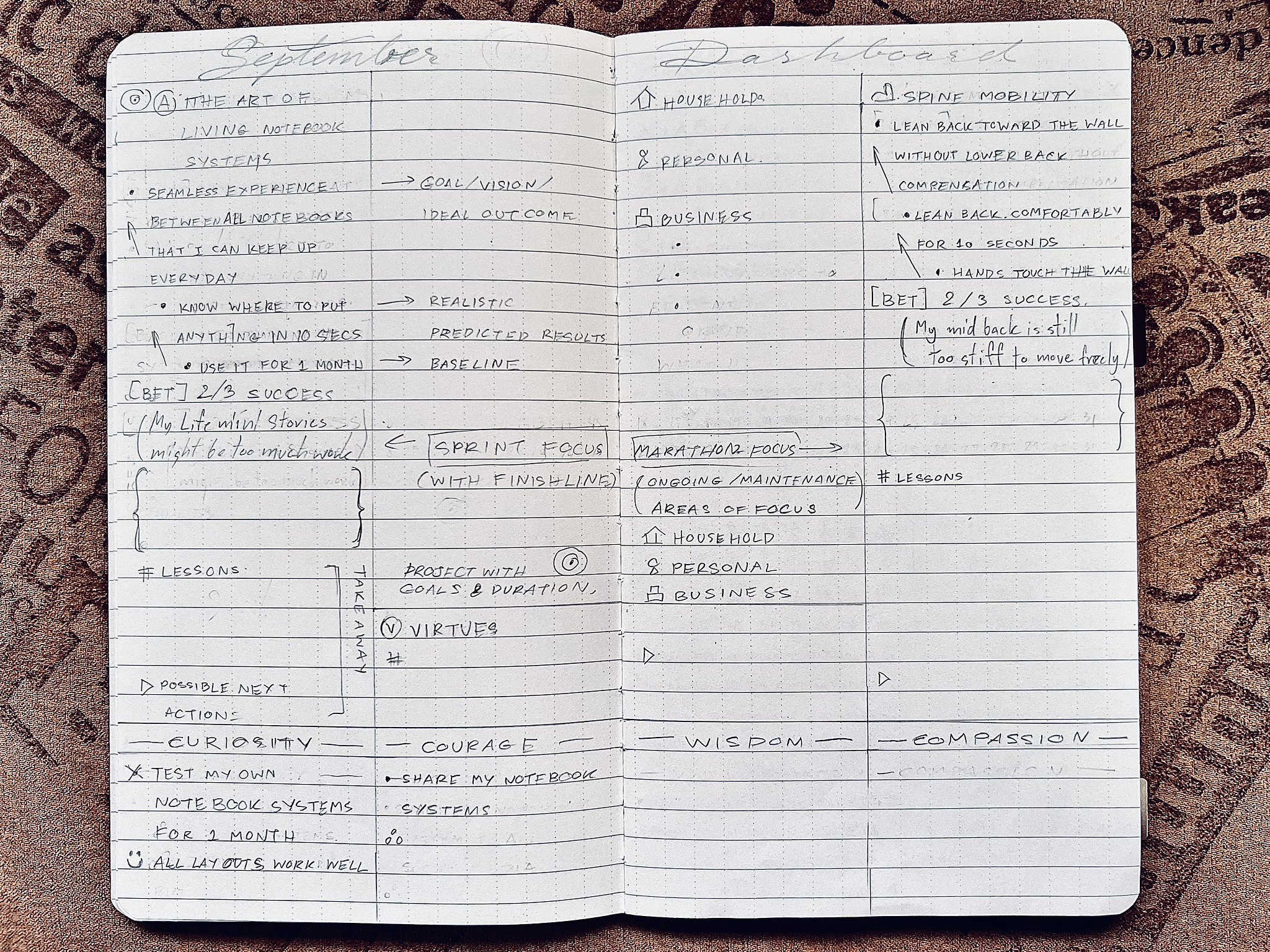
This layout categorizes your focuses into Four Focus Forces (four key areas of focus), so you can plan what you intend to do to have a well-round life, fulfilling roles and responsibilities on each aspect:
- Work (business and finance)
- Personal (hobbies and relationships)
- Health (physical and mental)
- Household (family and home)
Focus Forces
This is the focus of the month to put your energy and effort on. I recommend organising your focuses into two categories: 'sprint focuses' and 'marathon focuses' Place sprint focuses; goals with clear deadlines or completion criteria; on the left side of the page. On the right, list marathon focuses; which involve ongoing maintenance or long-term efforts; focusing primarily on routines. This way, you’ll have a visual hierarchy for your focus of the month.
Milestones
List your focus with associated success markers, ideally three milestones per focus:
- Baseline Outcome: The minimum achievable with minimal effort
- Likely Outcome: Realistic results assuming consistent effort
- Ideal Outcome: Your ambitious goal if you push yourself hard enough
I prefer to list them step-by-step, using indentation to clearly display the stages for each milestone.
Bet
While you set intentions and outline milestones, it doesn’t guarantee they’ll happen. This section encourages you to place a 'bet' on how likely you are to achieve your milestones.
Indicate your confidence in achieving them with a "Bet"—loosely inspired by Thinking in Bets. Estimate how many milestones you aim to complete for each focus and provide reasoning behind this judgment. Reflect on actual outcomes, lessons learned, and next steps. For example, you might bet on achieving only 1 if you want to prioritize other focuses, or if you're feeling extremely confident, aim for all 3.
Core Values
At the bottom, list your four vital virtues (the inner compass guiding your life.) Under each, record significant actions taken to embody these values. If space allows, include lessons learned, key takeaways, and possible next actions to support continuous growth.
The Monthly Intention:
It’s so easy to get swept up in the busyness of life, merely going through the motions instead of intentionally planning how you live. Here, you set clear priorities and decide how to distribute your energy and effort throughout the month. To ensure you address all your Focus Forces, we achieve this by
cascading from your monthly key activities and weekly fixed events into your daily schedule.
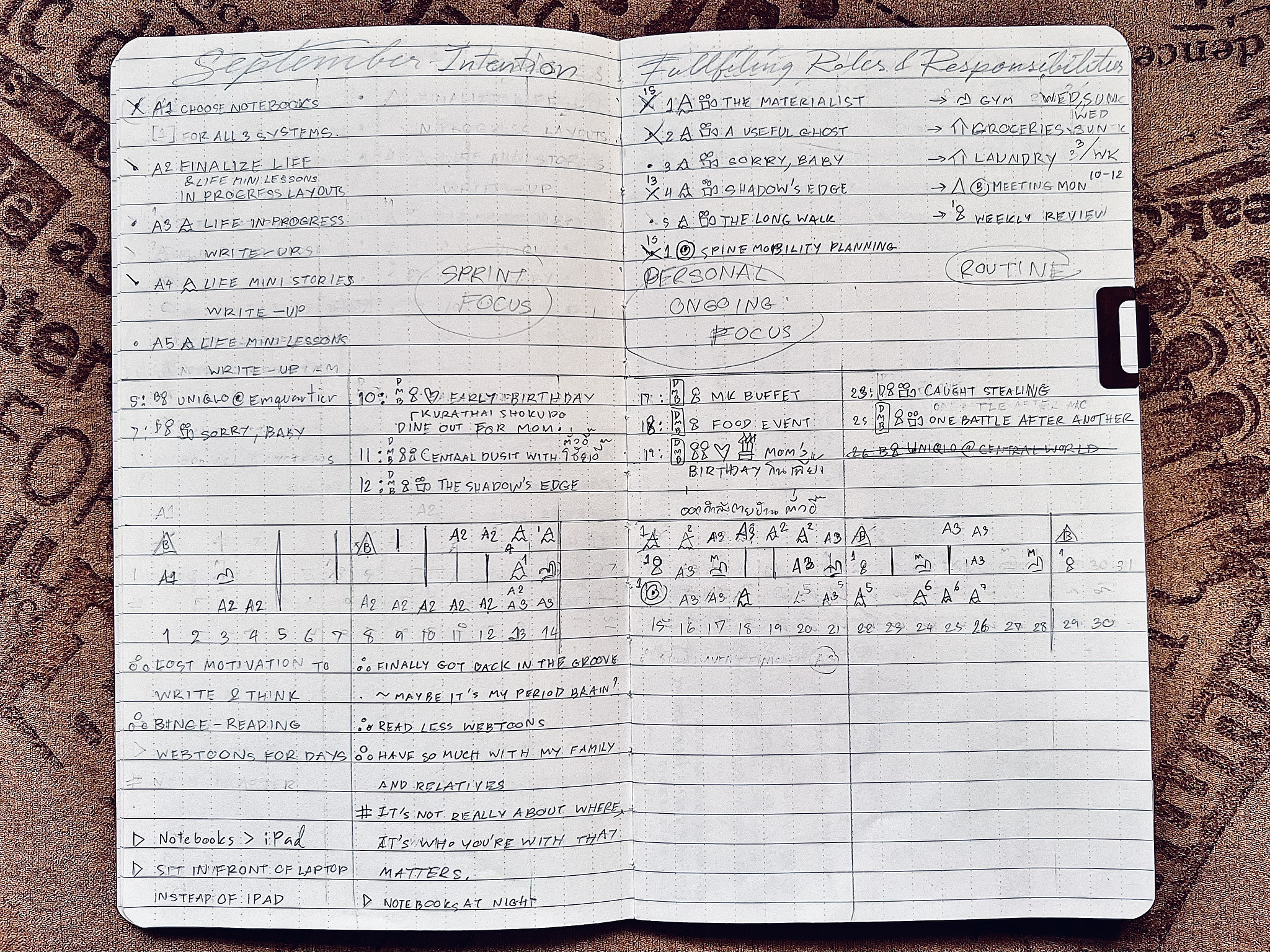
There are four sections in this monthly intention layout.
- Monthly Focus: Outline key responsibilities and activities tied to each Focus Forces, ordered from sprint to marathon efforts.
- Weekly Appointments: Structure the section into weeks. Schedule fixed-time events for each week to coordinate your commitments.
- Daily Schedule: A flexible plan dividing your day into morning, afternoon, and evening to allocate effort across focuses. This gives you a bird’s-eye view of your day, making sure that you allocate time for your key activities. While other tasks can be managed using separate tools.
- Weekly Reflection: Capture what worked and what didn’t, lessons learned, and possible next actions to refine upcoming plans.
Optionally, you can use a pencil board, with a sticky note on it, to highlight your yearly goals or critical monthly actions, keeping a laser-focus sharp amid noise of other lower important actions.
The Monthly Character Log:
As Aristotle said, "We are what we repeatedly do; therefore, excellence, then, is not an act but a habit." This means, then, that your behaviour, what you consistently practice, defines who you truly are. And your character forms from consistent practice aligned with your values.
If you want to build a character, you must choose what to practice and make it a habit. You decide this by having a personal inner compass guided by your values and virtues. It's not enough to merely set intentions; you must also take action.
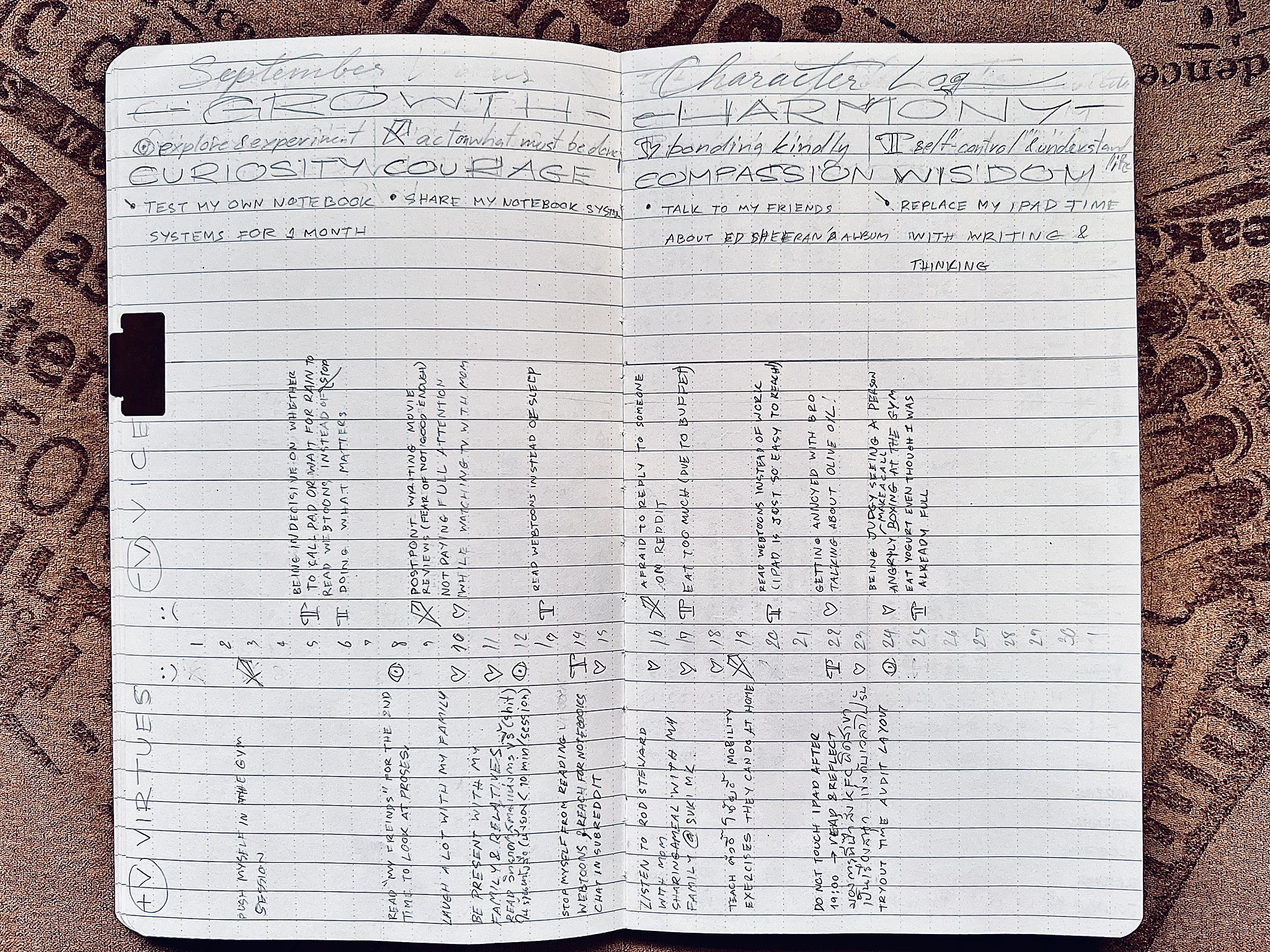
This Monthly Character Log provides a space for documenting evidence of your character development. Ensuring you're on the right path to embodies your personal virtues—your core values that act as a guiding north star. This space invites you to clarify and revisit what matters most to you, so you can consistently align your actions and decisions with your authentic self as you navigate life’s journey.
This log records evidence of character growth:
- Core Values: Start by writing your chosen core values. Defining personal values is one of the most meaningful things you can do in life. If you're still discovering yours, you can temporally borrow mine: Curiosity and Courage, which foster Growth, and Compassion and Wisdom, which cultivate Harmony. However, feel free to select only values that resonate with you.
- Intended Practice: List one monthly action per value. It doesn't have to be significant or a daily activity—just something meaningful that aligns with your values. Leave some blank space to reflect on your progress at the end of the month.
- Value-based Reflection: Reflect monthly on alignment with your values and areas to improve and strengthen your character in the following month and beyond.
-
Vices and Virtues: Flip the notebook and divide two columns beside the dates.
- Virtues: record daily positive actions or thoughts that align with your chosen values.
- Vices: record any negative actions or thoughts that divert you from your values.
The key is to document positive actions and thoughts that guide you towards your virtues and values, alongside those that lead you astray. What's important is recognising both the positive and negative influences on your growth. This serves as tangible evidence of your character building.
The Monthly Accountability:
This is the space where you hold yourself accountable and steer your course. By monitoring whether your actions align with your virtues and goals, you stay actively in control of how you live on a daily basis.
I view this layout as an upgraded version of habit tracking. With traditional habit tracking, you simply records whether you performed the habit or not—a binary yes or no, with no consideration for the degree of actions and reflection. However, this accountability tracker allows you to log varying degrees of skills and effort, and reflect on progress towards your goals or focus. This allows you to daily observe your life’s progress even when you’re not fully dedicating your time and energy fully to that focus.
The structure for this layout is quite similar to a character log layout, you write down the dates, dividing into two columns.
- On the left side, group any actions you’d like to perform regularly together in your own meaningful way to suit your personal objectives (whether by focus, goal, theme), and preferably organize the action from the least effort to the most effort (from left to right).
- On the right, document notable remarks daily, preferably prioritizing from most to least effort (from right to left), making it easier to decide which activities to reflect on. Use these remarks to understand successes, setbacks, feelings, and plan forward.
This accountability acts like a partner you answer to honestly, providing concrete evidence of your journey. It feels similar to having an accountability partner or group—discussing what you did, what you didn’t do, why, and how to move forward. However, rather than sharing with others, you’re answering to yourself, supported by clear evidence and daily "breadcrumbs" that highlight your progress.
Each day, take a moment to reflect and ask yourself: What did I do or fail to do? What went wrong? What went right? How do I feel? What stands out about my actions? This reflective process fosters accountability for both your actions and inactions in relation to your intentions.
Knowing that you must account to yourself for what you did (or didn’t) and how it went makes you more attentive to details. This practice is a form of selective attention, where you set up your attention radar and fine-tune your focus to capture any relevant information aligned with your goals and intentions.
My Accountability Trackers
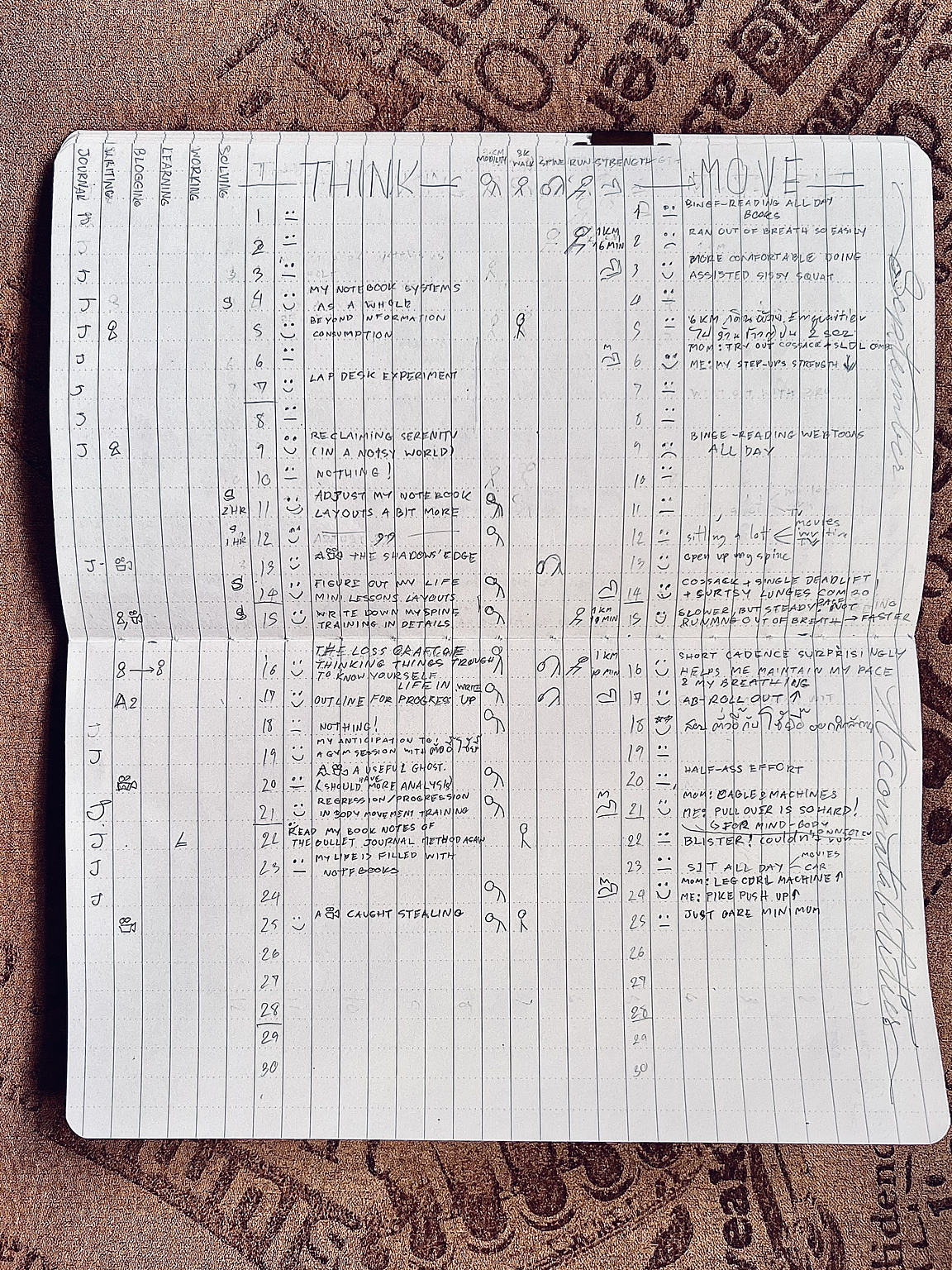
I believe that the essence of being human lies in our ability to think and move. Therefore, I’ve currently organized my accountability into these two groups, tracking daily activities related to each. (I might add more trackers later.)
I personally organize habits and actions based on their intensity. For example, a mobility workout is my bare minimum for physical activity, so I place it on the far left. Activities requiring more effort, like walking, sprinting, and strength training, are placed further to the right. This arrangement helps me identify which actions deserve detailed reflections—typically, those on the right, such as gym sessions, rather than less intense routines like morning mobility drills. If I have an inactive day—just sitting around—I note it down, perhaps with a sad face, and honestly answer to myself why I didn’t take any action.
Some Accountability Ideas
- Work: Tracking activities such as meetings, planning, problem-solving, and sales. Consistently engaging in these actions will help you progress toward your business goals.
- Sprint Focus: Tracking key activities and jotting down reflection or next steps in a notes section.
- Household: Tracking tasks such as laundry, cleaning, decluttering, and meal planning.
- Health: Tracking your meals, medications, and nutritional intake—monitoring proteins, vegetables, carbohydrates, and other macronutrients. You might also note your recipes or ingredients to gain a clearer understanding of your consumption habits.
You can adjust your accountability trackers based on your current monthly focus, or your cornerstone routines.
But remember to start small with manageable habits that you actively do in a daily basis first, so you can build the habit of tracking, observing, and answering to yourself honestly. Over time, you can expand your accountability areas or adjust your system to identify more patterns in your progress
Quarterly Reflection
Quarterly Reflection is a dedicated space to pause, review your journey, and uncover the key takeaways, lessons, and insights you’ve gathered along the way.
Throughout the quarter, you reflect monthly on growth, lessons, and wisdom. These insights are then consolidated into four distinct quarterly review layouts: Milestones, Focus, Integrity and Lessons.
You metaphorically drop your Anchors to stabilize and ground yourself in the core dimensions of life: Wins, Joy, Social, and Health. During this time, you consult your Inner Compass, your core values, to realign with what truly guides and motivates you, ensuring your path remains authentic and purposeful. You check-in with how your Focus Forces and Steering Wheel have been serving you.
Then, you explore This Quarterly Reflection, reviewing the continuous narrative of experiences, challenges, and growth recorded throughout the months. Waypoint Logs mark significant milestones and turning points, offering insights into how you’ve navigated your journey and highlighting where adjustments may be needed.
The Quarterly Milestones:
Quarterly Milestones are your Waypoint Logs. This layout captures significant wins and highlights from each week across the quarter, serving as markers to guide your future course corrections and personal growth.
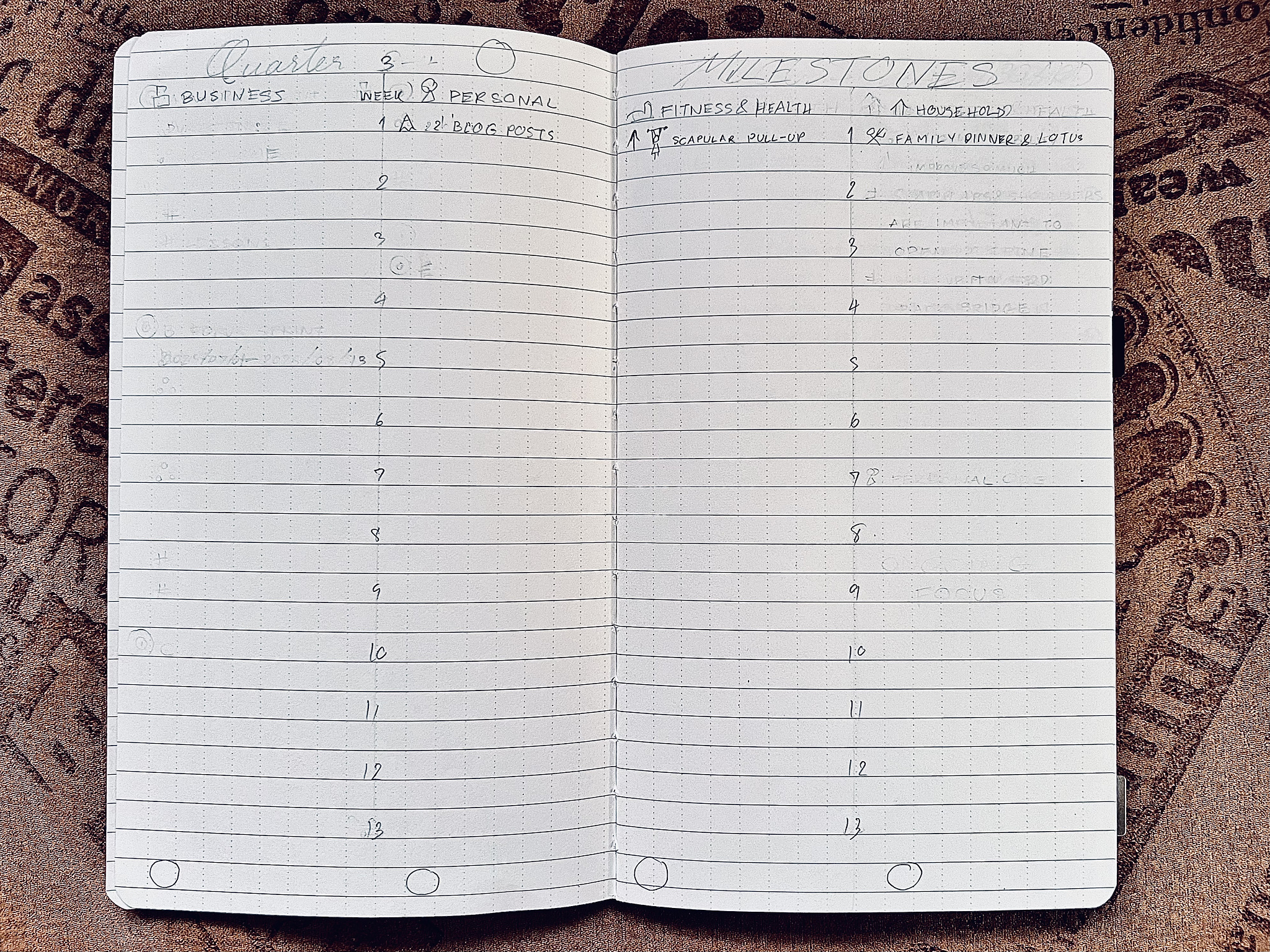
Write week numbers centrally and note your biggest wins within the Four Focus Forces:
- Work (Business and Finance)
- Personal (Hobbies and Relationships)
- Health (Physical and Mental)
- Household (Family and Home)
After the end of the quarter, add a stamp or emotive face—such as a smiley, meh, or sad face—to express your overall feeling about each area for the quarter. Together, they create your personal map of wisdom and growth.
The Quarterly Focus:
List your ongoing and sprint focuses for the quarter, preferably from your Four Focus Forces, and reflect on outcomes and lessons learned.
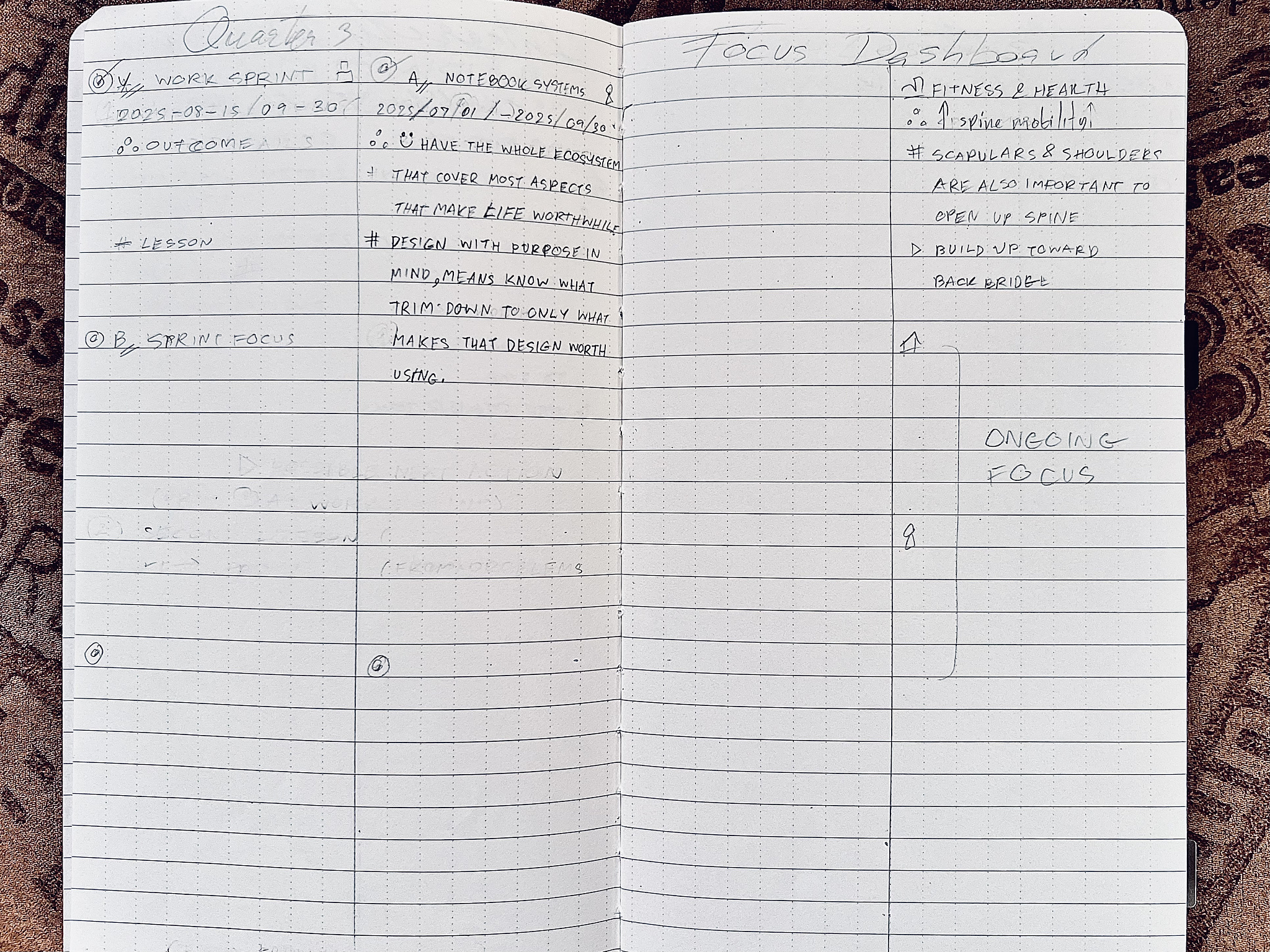
Ongoing efforts go on the right, sprint focuses on the left, providing a clear visual of your priorities and progress. Then, document insights gained and outline potential next steps.
The Quarterly Integrity:
Under your core values, document big actions taken toward each one, lessons learned, key takeaways, and opportunities for growth to ensure your life honors your guiding principles.
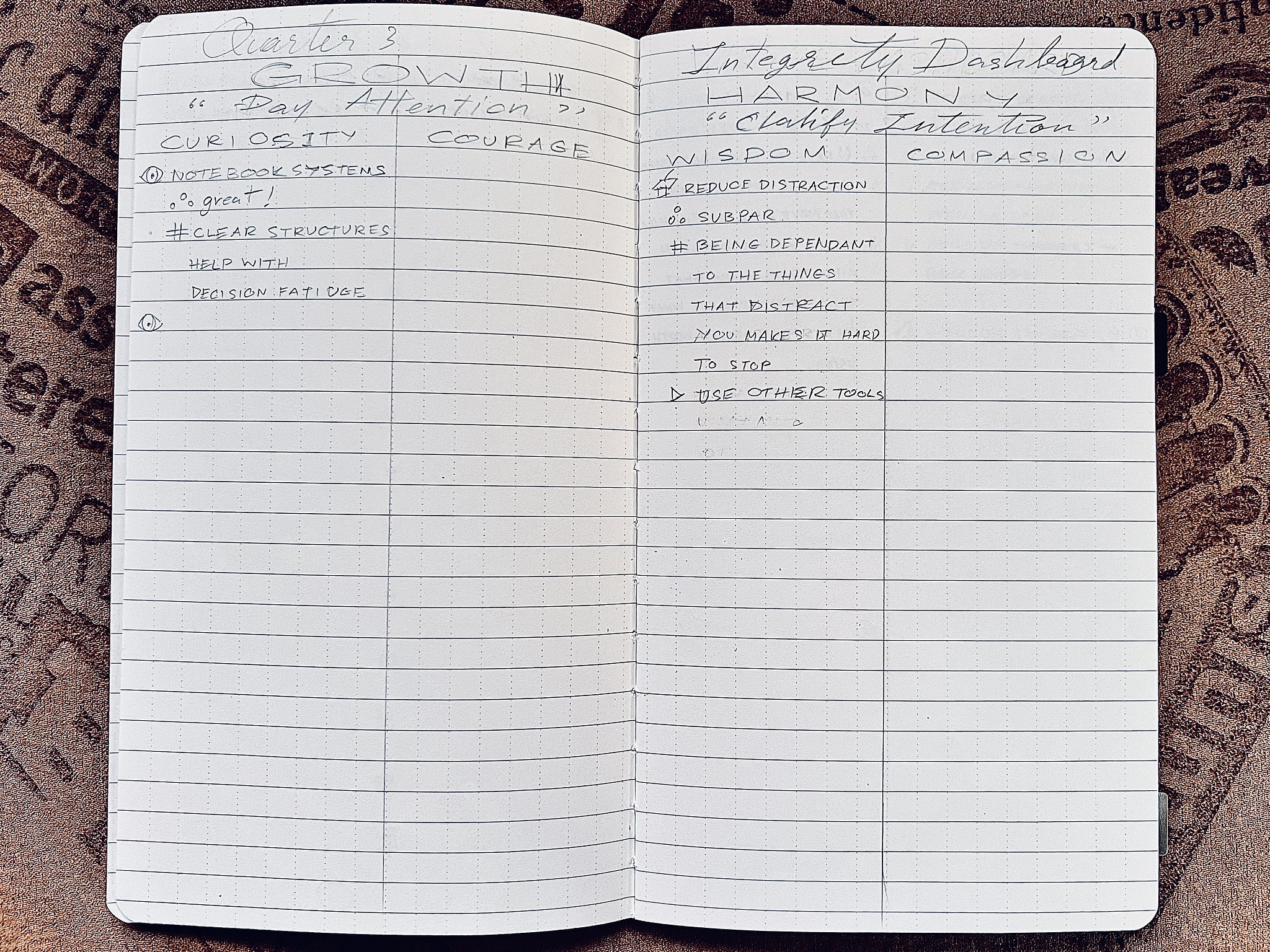
The Quarterly Lessons:
This final section invites you to distill the quarter’s most impactful key takeaways. Try to pick takeaways that you’d like to bring with you on your next quarter. Reflect deeply on how these insights have influenced you and how you intend to integrate them further.
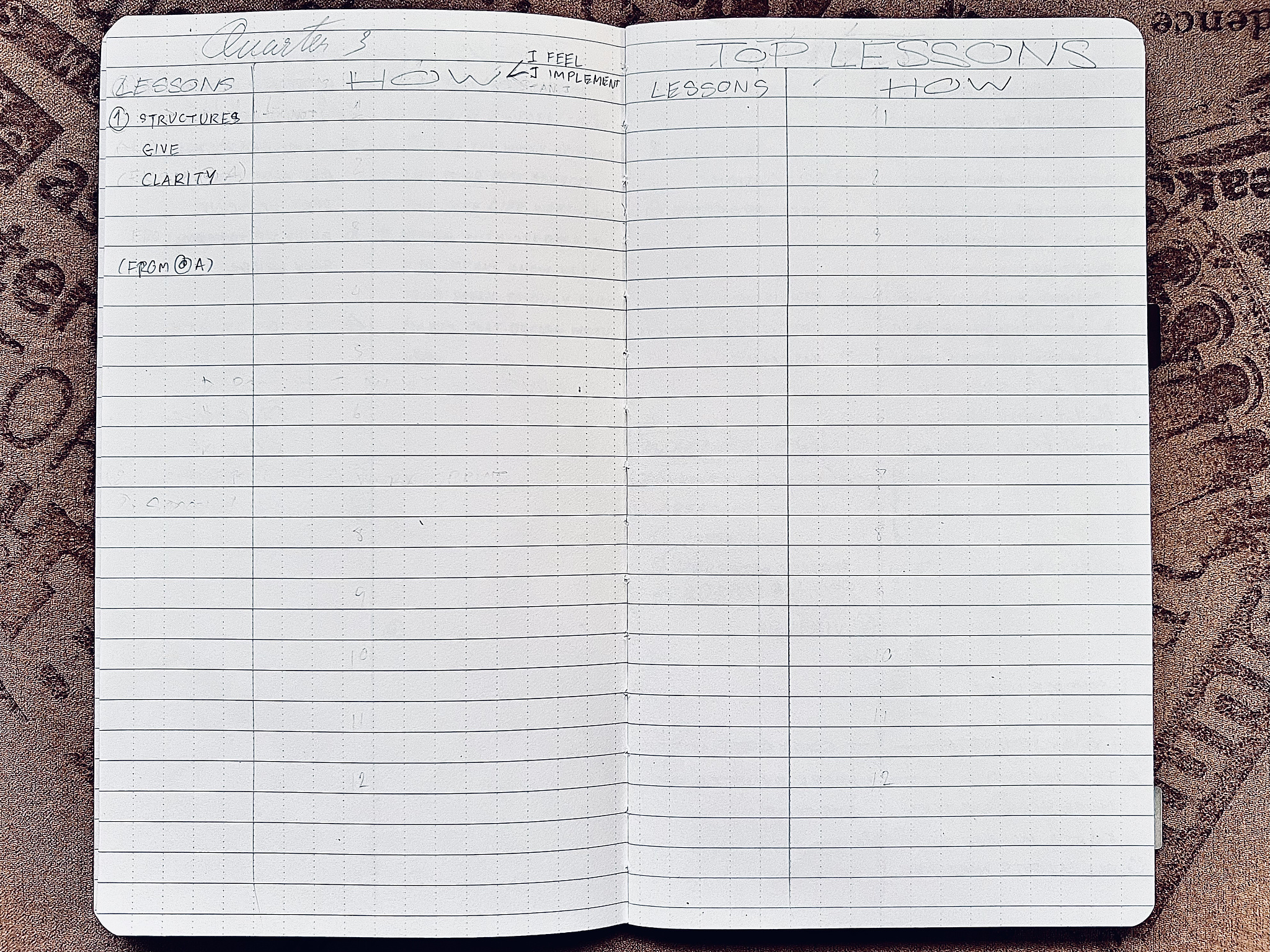
Write down your key lessons, your feelings about them, how you have implemented them, or how you plan to implement them in the future. This way, your lessons become living wisdom guiding the next phase of your growth journey.
The Support System: Life in Focus
Life in Focus is outcome-based, with progression driven by achievement. It zooms in on individual projects and commitments, offering a laser-focused approach to each step and the direction you wish to pursue.
Because areas of focus and their scopes vary widely person-to-person, Life in Focus encourages customization. You can design your own layout styles, a dedicated notebook, or even go fully digital; the choice is yours. What matters is that you have a space to implement a similar approach to structured thinking and extracting meaningful takeaways. This should at least include an overview of focus areas, milestones, key activities, and reflections.
So, for this support system, I’ll be explaining the concepts with some examples instead.
"Life in Focus" is the support system designed to fuel your life’s progress through an outcome-based approach. So you can determine what to concentrate on, identify your core areas of focus, and reflect on your vision and results. The unique energy behind this system is momentum—the more you move, the easier it becomes to keep moving.
Life in Focus organizes your efforts into two primary types, categorized by whether there’s a finish line—either by completion or deadline:
- Marathon Focus: Long-term, ongoing activities that build momentum steadily over time. These usually represent regular, maintenance-oriented actions across 4 Focus Forces (Work, Personal, Health, and Household.) While these don’t always require full attention, consistent effort keeps your life’s engines running smoothly.
- Sprint Focus: Short-term, outcome-driven projects demanding laser-focused energy and attention. Sprint Focuses are defined more by milestones rather than strict schedule, prioritizing “what” you want to achieve over “when.” These are project-like bursts designed to generate breakthrough progress.
Imagine that you’re running a marathon, there are times you want to pick up the pace. That's when a marathon shift to sprint pace. You might set your sprint based on a specific duration or after passing certain distances or goalposts before returning to a steady rhythm.
Marathon Focus is primarily what builds your Focus Forces—consistent actions that create momentum in various aspects of your life (work, personal, health, household). These are tasks that generally don’t require your full attention and effort because you already know what needs to be done. As long as you perform them regularly, the engines of your life keep running smoothly.
However, when situations arise that prompt you to concentrate intensely and channel your full energy and attention into specific tasks, it becomes a Sprint Focus—a project aimed at achieving a particular outcome by setting short-term goals or hitting specific milestones.
In this way, Sprint Focus isn’t inherently time-bound but rather outcome-focused. You prioritise milestones first, with deadlines for each specific action considered afterward.
It’s not really about when you complete tasks, but what you achieve during that time, and how your actions and planning support those milestones.
Marathon Focus Example: Household
Household management is a clear example of a marathon focus. I categorize household activities into four groups: Food-related, House-related, People-related, and Stuff-related.
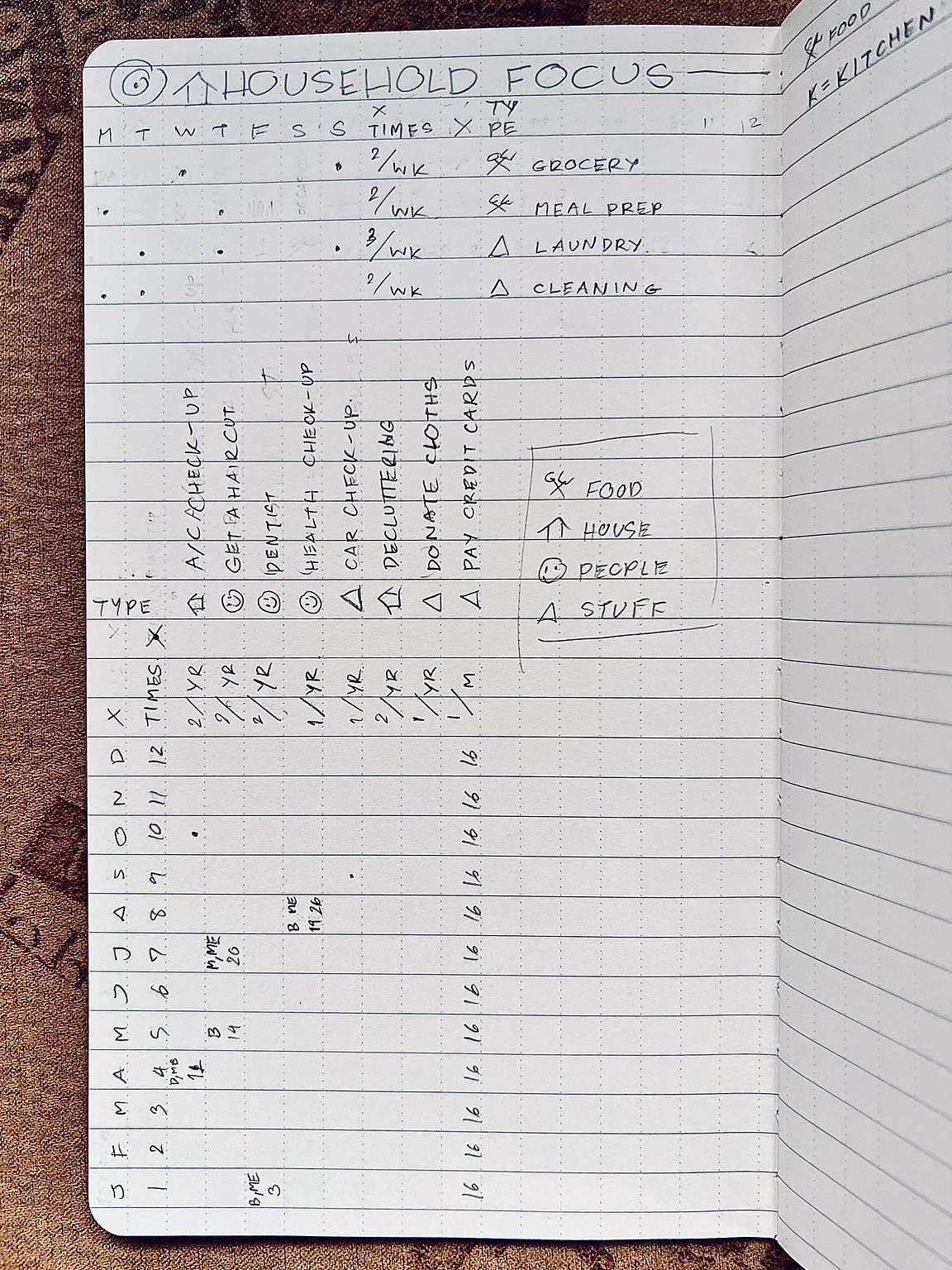
I track these using simple weekly and yearly trackers—marking planned frequency with dots, and logging completion with dates. Simply write how many time you want to do that activity and put on a dot on your planned time, then when it’s done, you wrote the date. That’s it.
Sprint Focus Example: Fitness
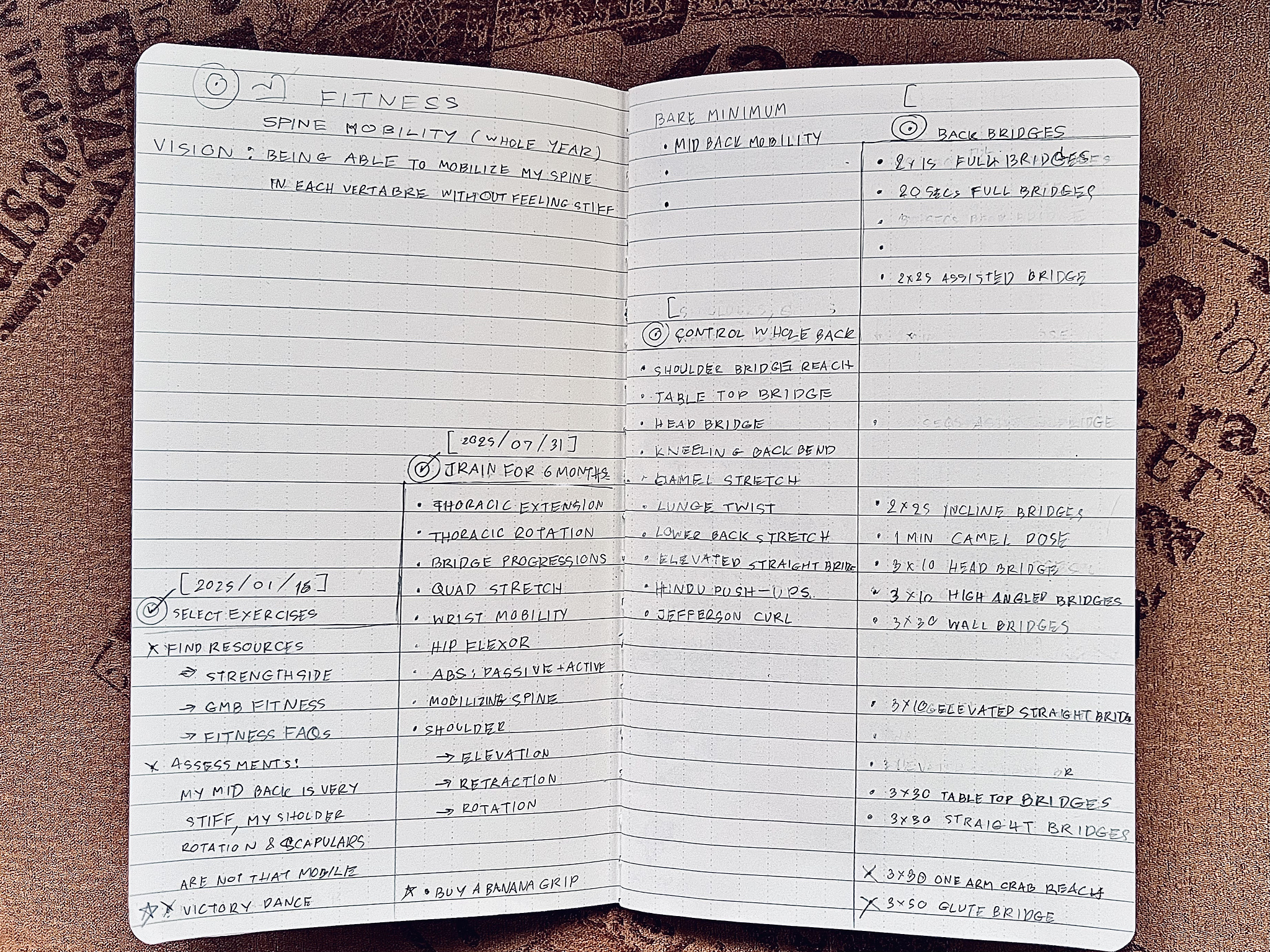
I envision what I want for this Fitness Sprint (a whole year, in this case, because mobility is something you cannot rush, unless you want to break some bones in the process, lol). Then I consider the actions needed to achieve my vision, then establish a milestone launchpad to guide progress.
I conceptualise milestones as four distinct stages, each representing a step towards success. These progressive milestones are designed to guide you in achieving your goals.
- Kick-off: Develop initial checklists and assess resources, considering constraints like time, finances, and energy.
- Accelerate: Identify key activities and estimate how long it will take to build momentum.
- Overcome Pitfalls: Recognise potential bottlenecks and pitfalls, and determine strategies to improve and adjust your course.
- Wins: Celebrate all achievements, from bare-minimum milestones to overarching goals.
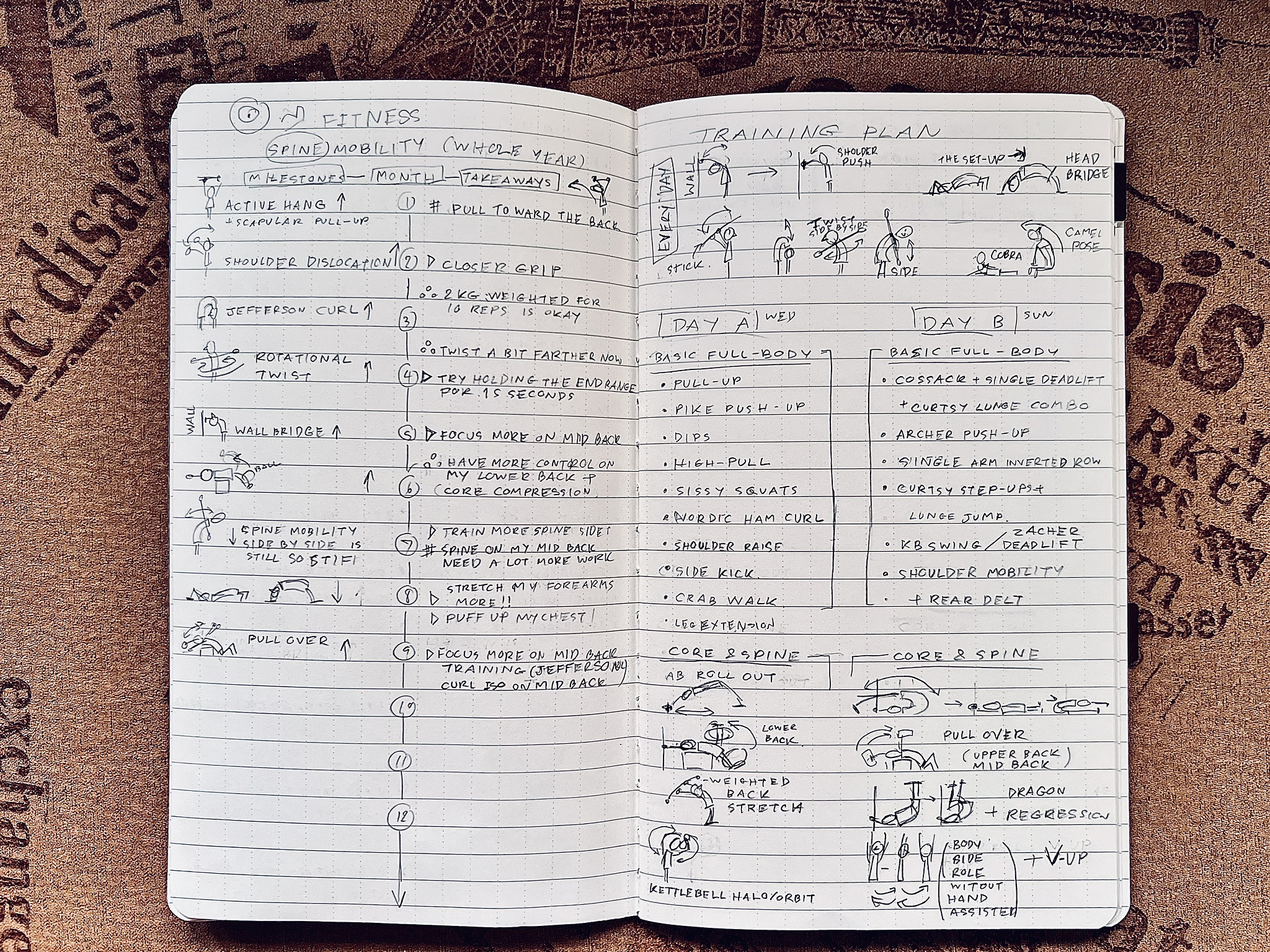
Then, I have a weekly milestones and takeaways in a form of a timeline of the quarter, along with my workout plan for that quarter. Documenting key takeaways at each step helps maintain clarity and momentum.
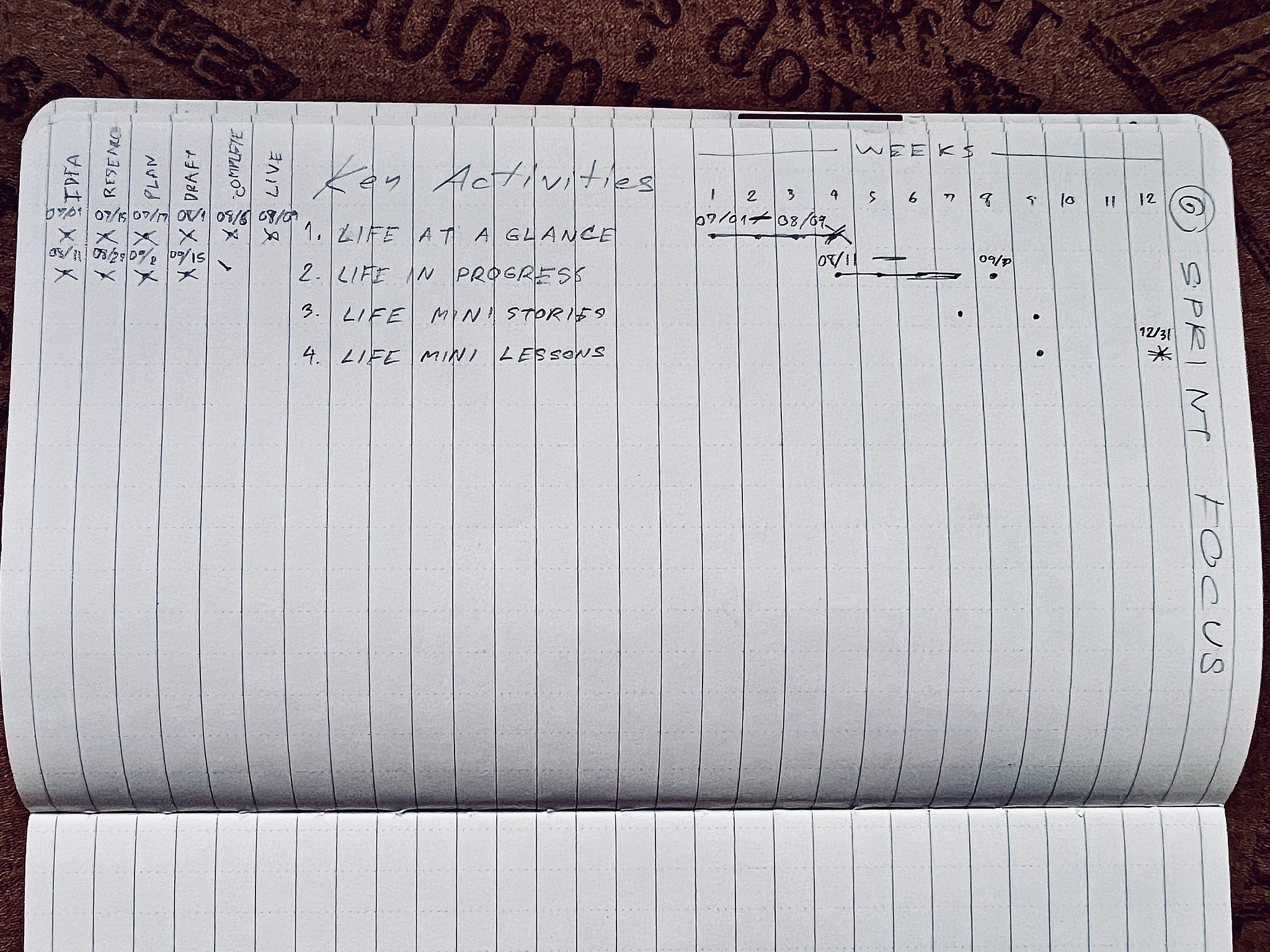
If you prefer paper planning or tracking your milestones using a Gantt chart, you might organise your workflow into stages, e.g., Backlog, In Progress, and Finished. Then, list key activities and map them onto a timeline. However, I believe digital tools are often more effective for this purpose.
In summary, Life in Focus empowers you to maintain steady momentum complemented by targeted bursts of progress, shaping a flexible yet outcome-driven path towards your goals.
Final Words
With Life in Progress, I barely ran out of things to reflect on.
Each night, instead of struggling to organize my scattered thoughts or searching for something to write about, I simply flip through each page and jot down a few remarks in response to the structured prompts. These notes instantly form a progression pattern, ready for deeper reflection. Filling out these forms before bed leaves me with the satisfying feeling that I have lived a full day, taking meaningful steps for my future self to examine and grow from.
I believe the Life in Progress system beautifully complements the Life at a Glance system. While Life at a Glance balances your life dimensions with joy and meaning, Life in Progress focuses on how you purposefully live each day. It fosters profound reflection and encourages you to contemplate each step and its impact without losing sight of your overall trajectory.
This notebook helps me see life not as isolated daily events but as a continuous, purposeful journey. It enables me to recognize my movement forward, beyond merely listing tasks, by observing the progression, direction, and timeline of my life with intention and clarity.
Life in Progress gets me to pause and reflect, trying to understand my life backwards, while also setting intentions and visions for how I want to live moving forward.
There’s no need to go fully analog. In fact, I encourage you to complement the Life in Focus system with digital tools to keep your life up-to-date with flexibility. And use Life in Progress and Life in Focus together to maintain focus on your future direction and preserve valuable breadcrumbs from the paths you’ve traveled.
